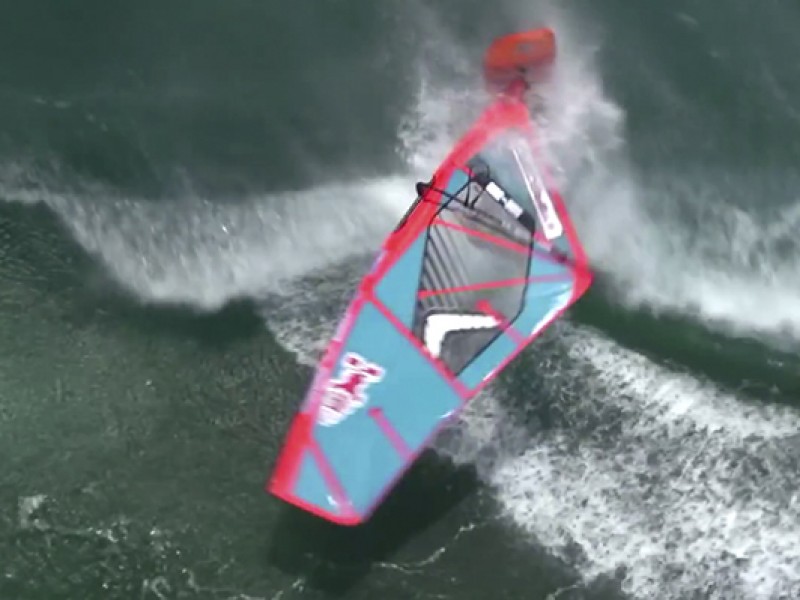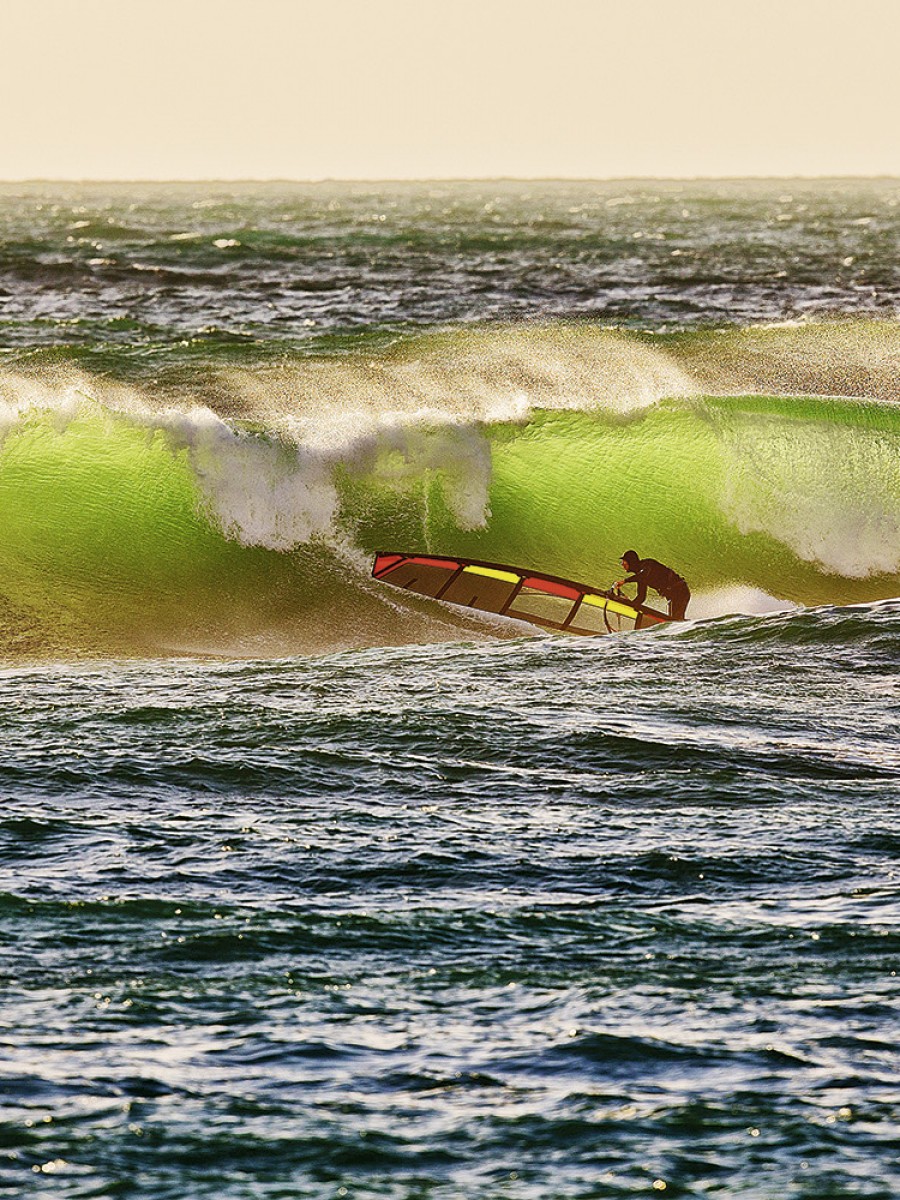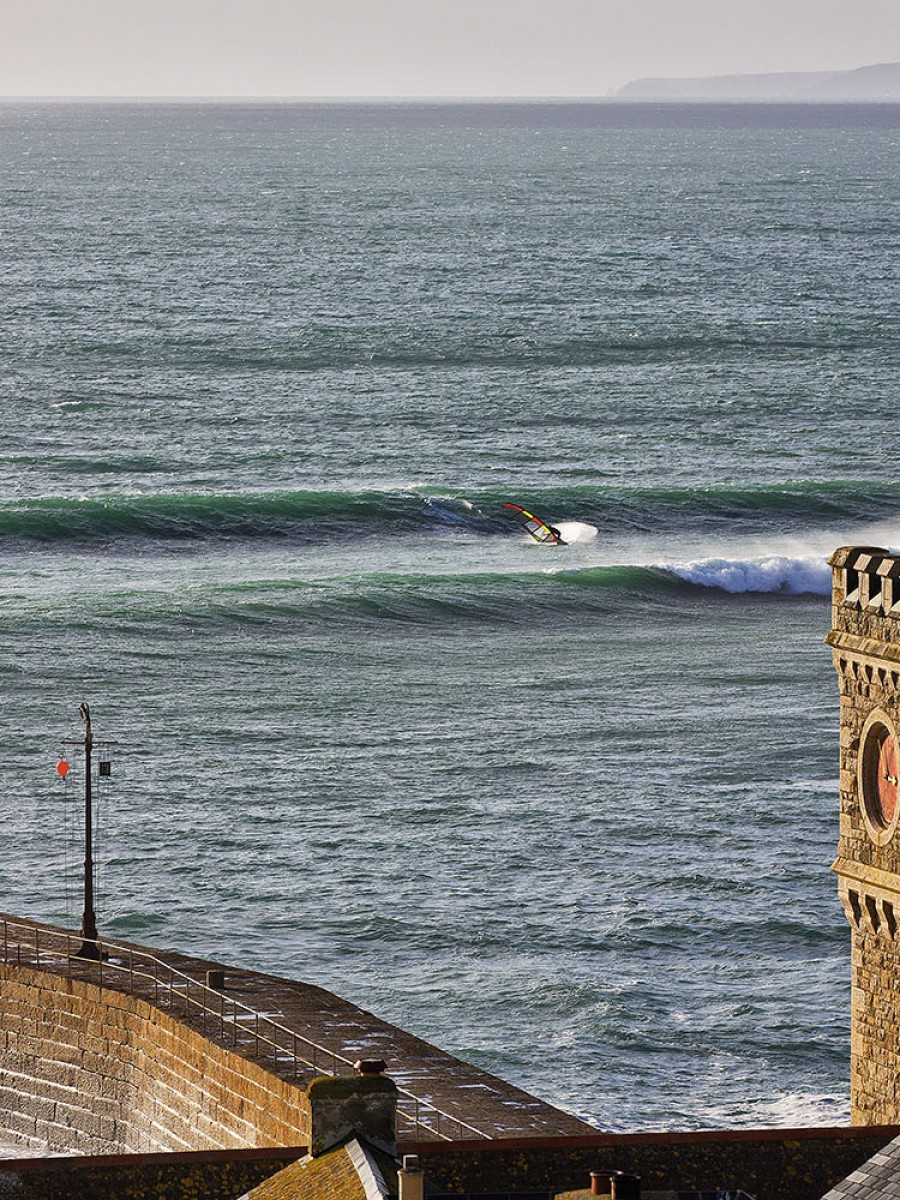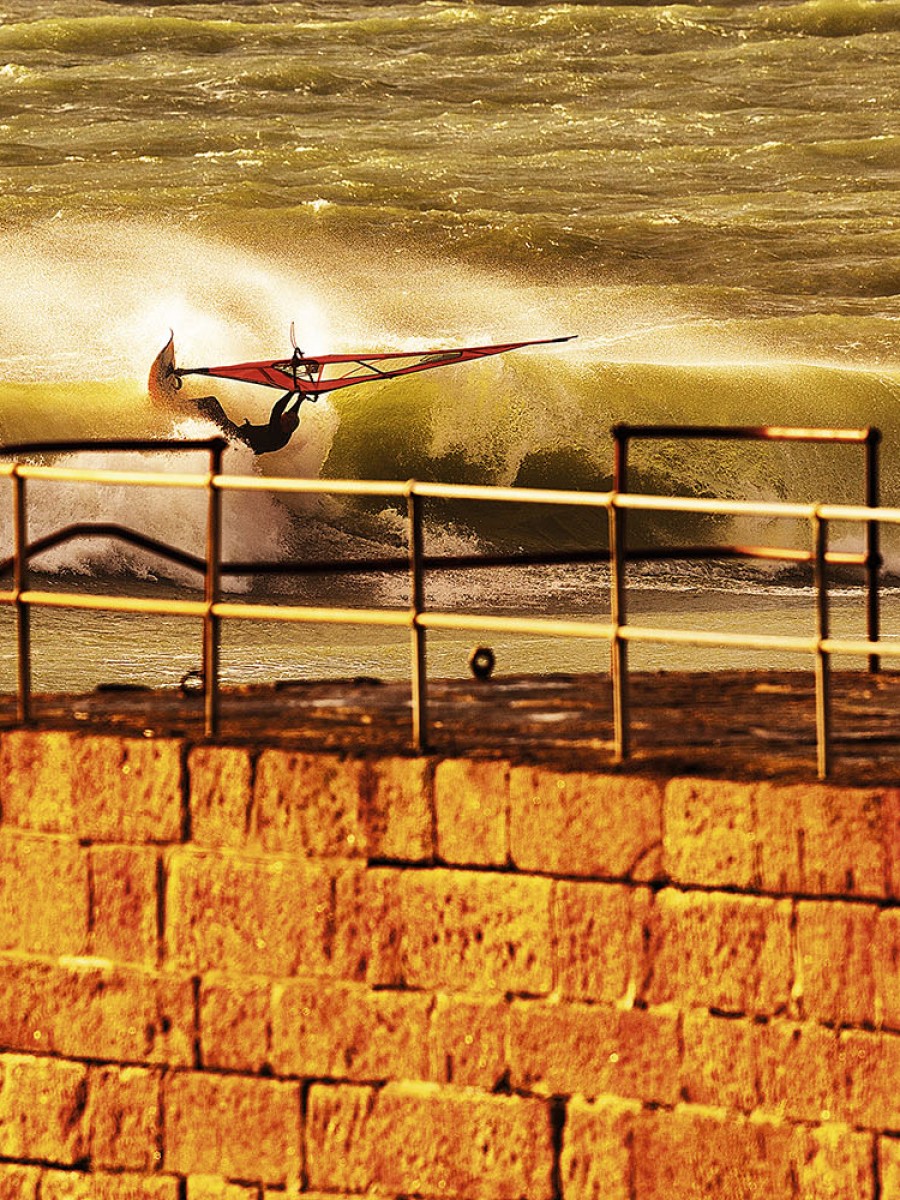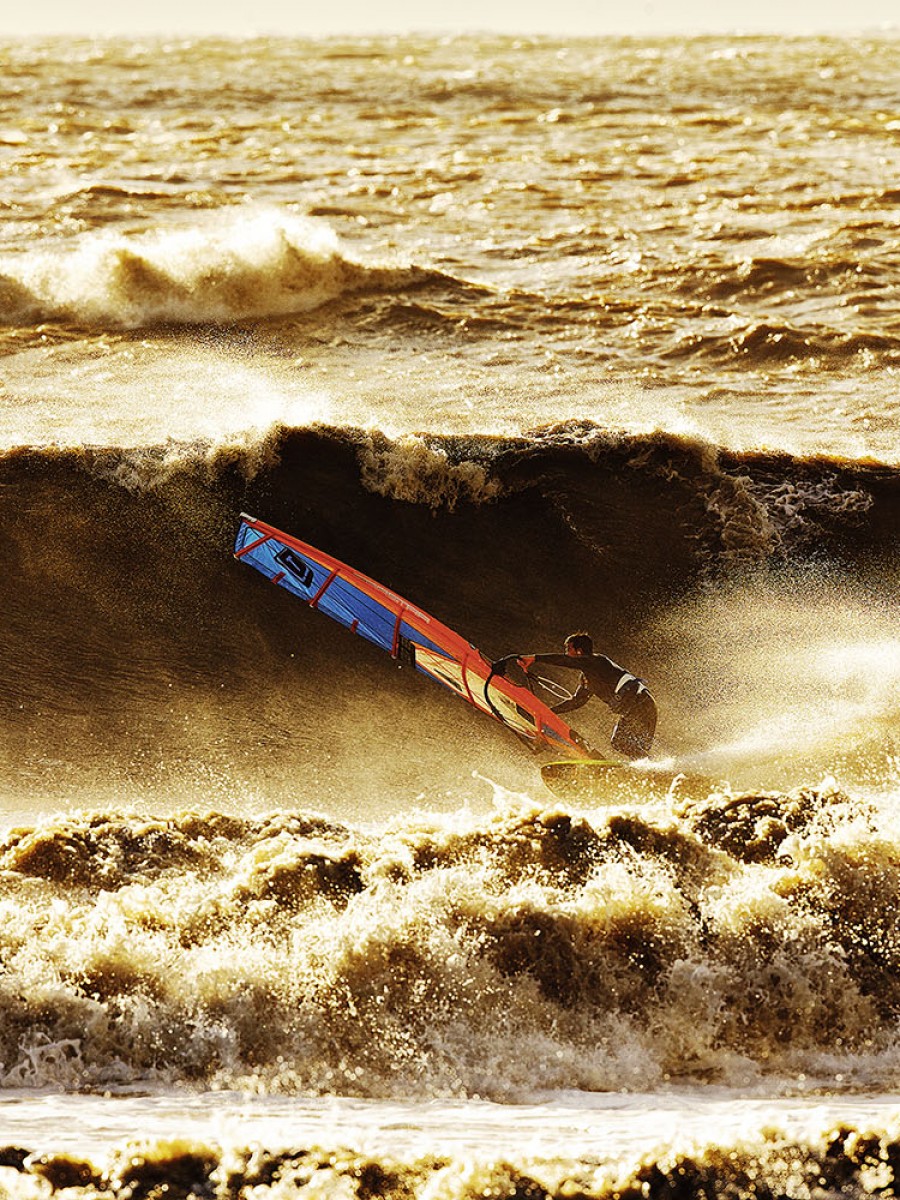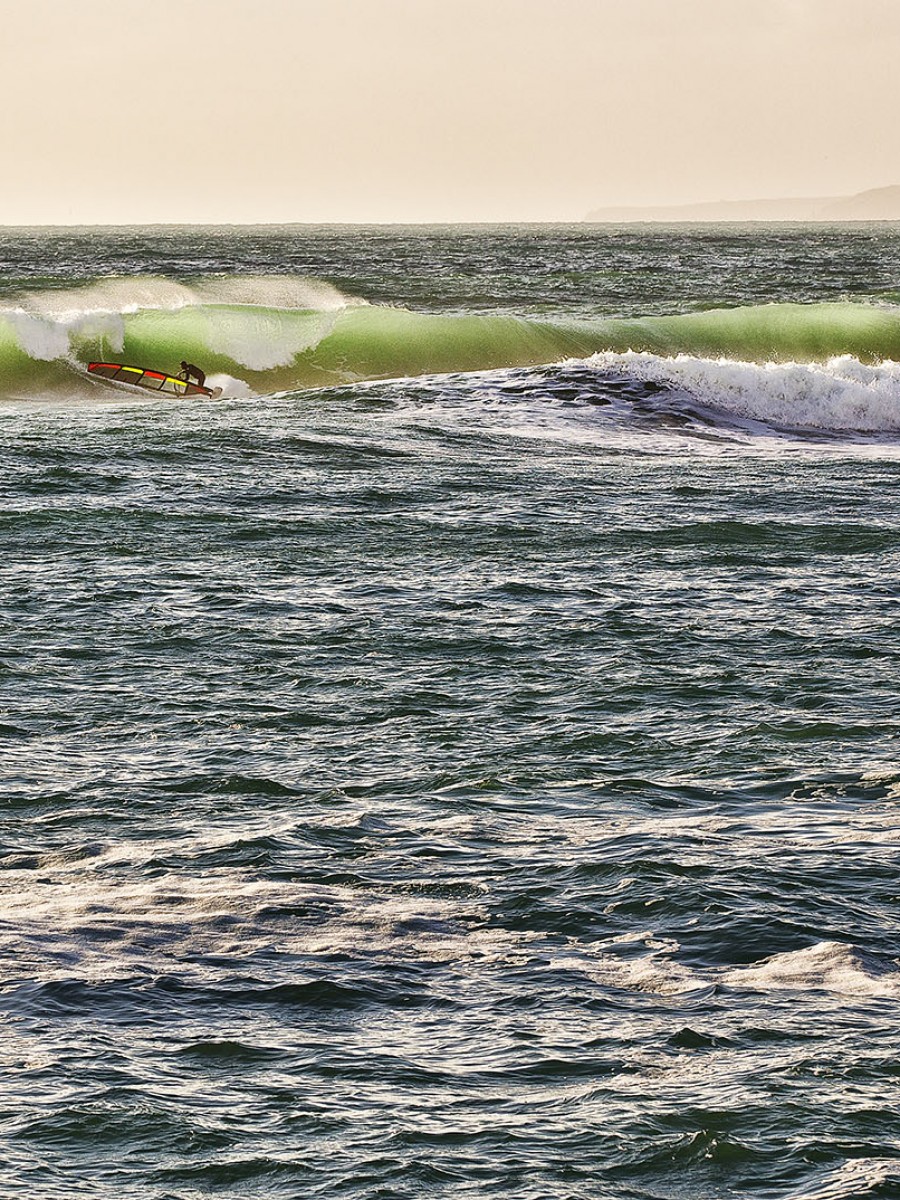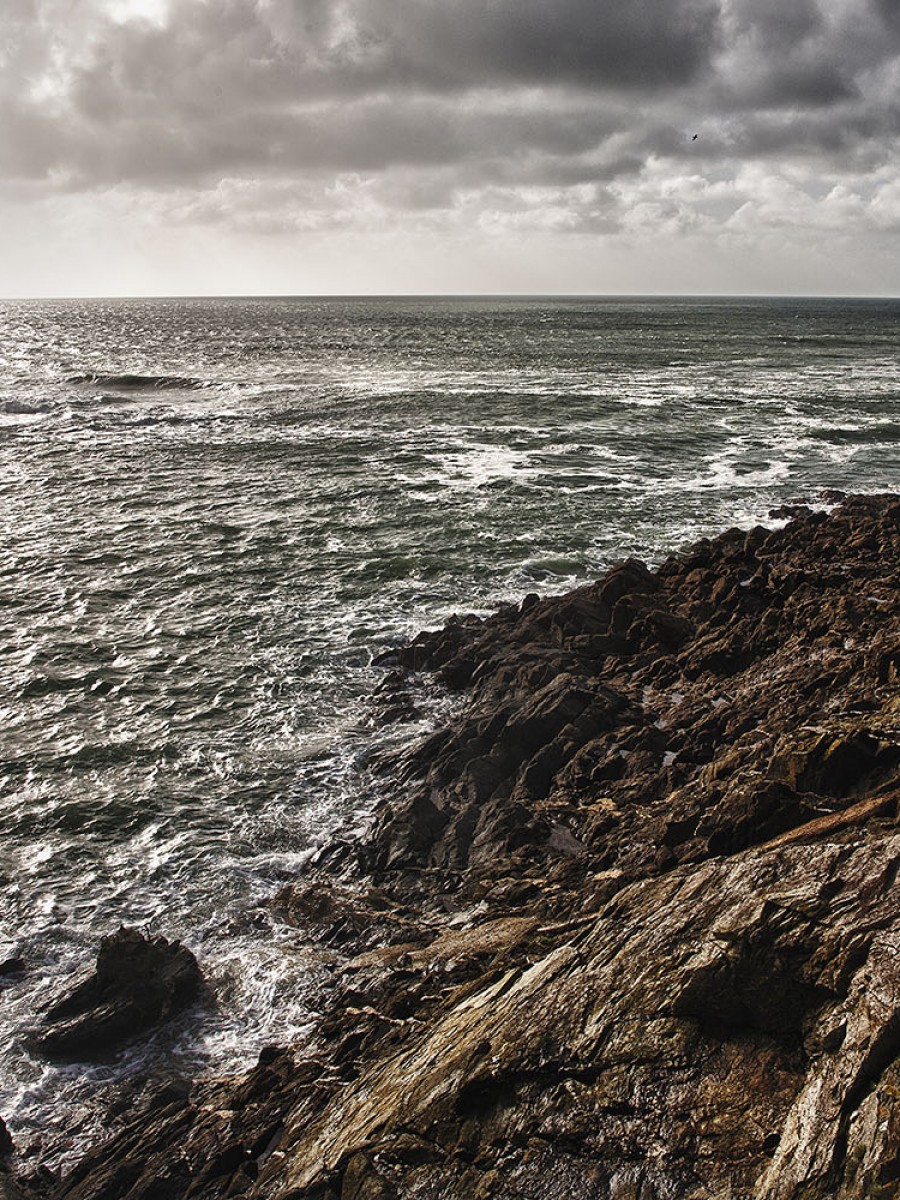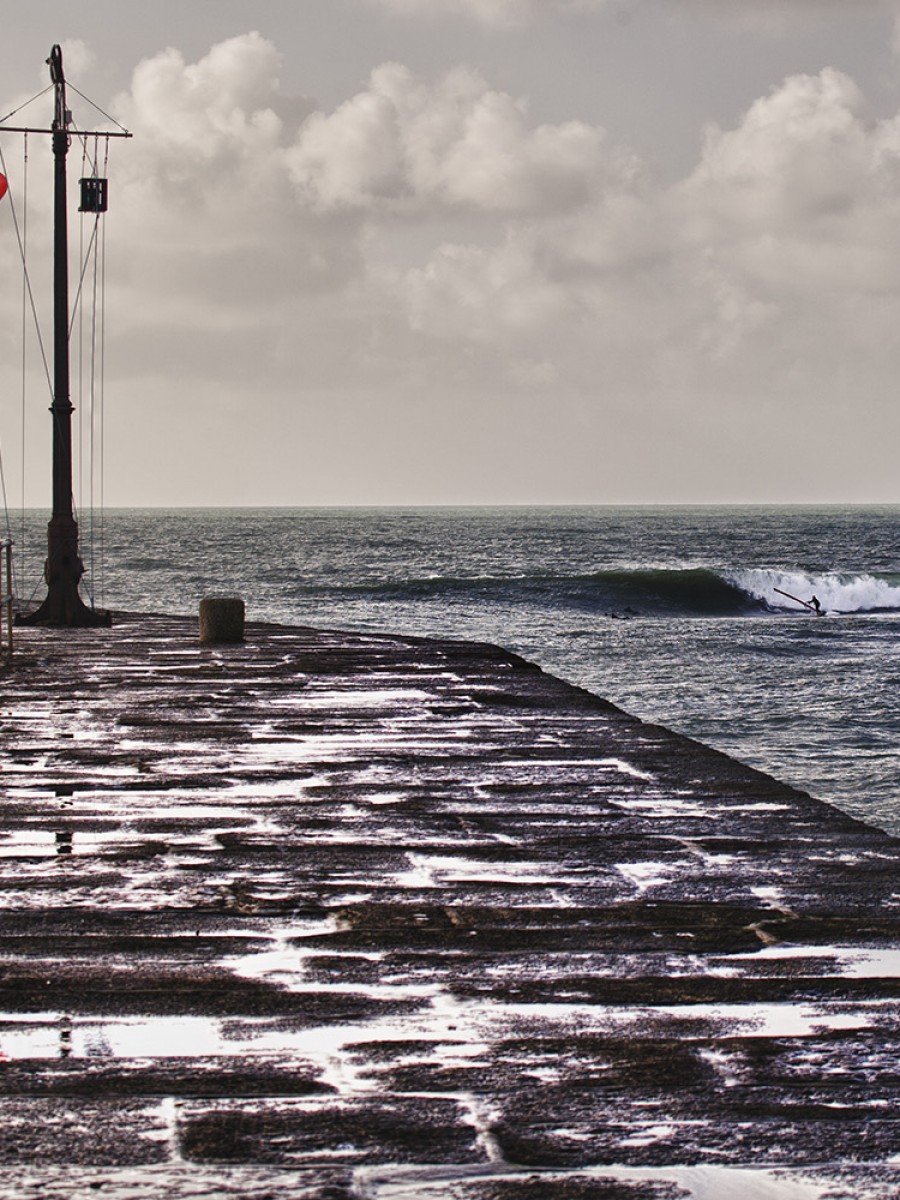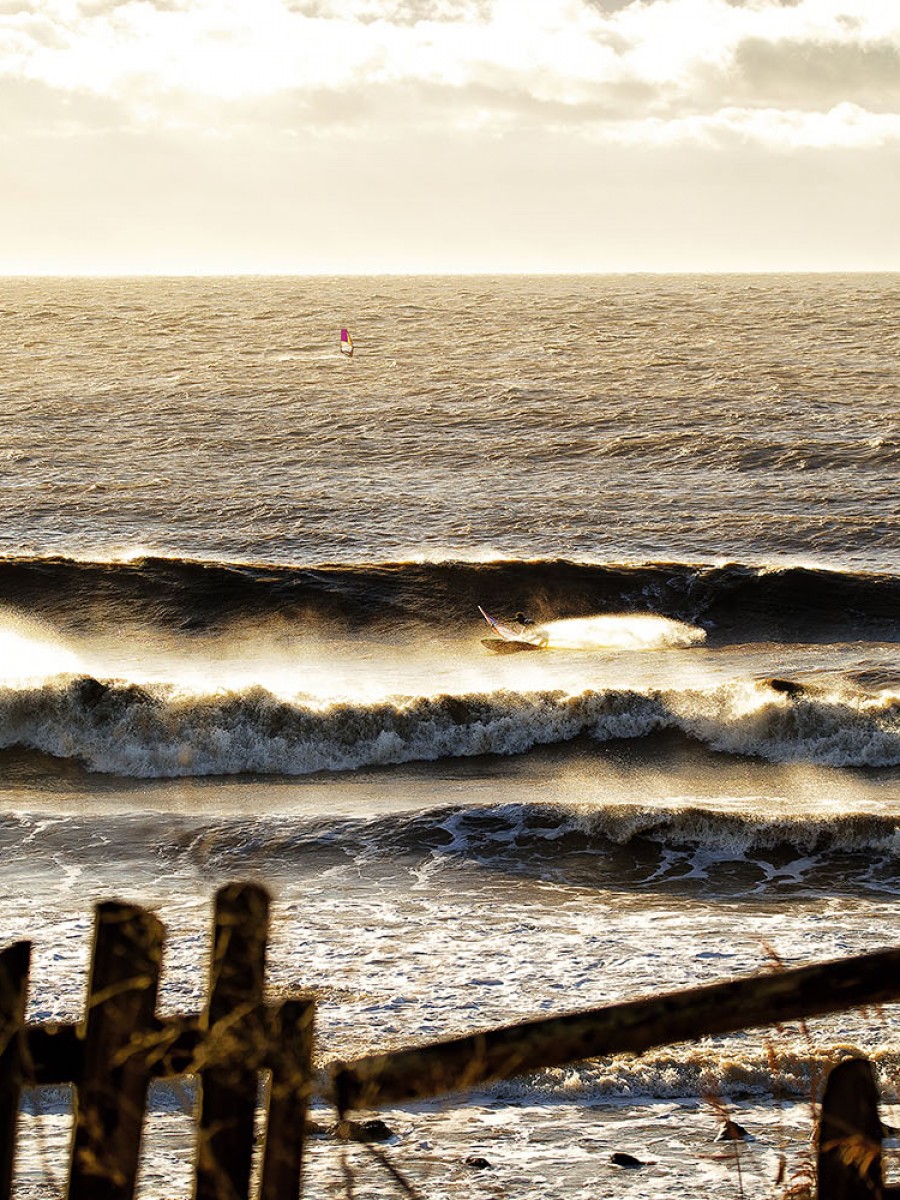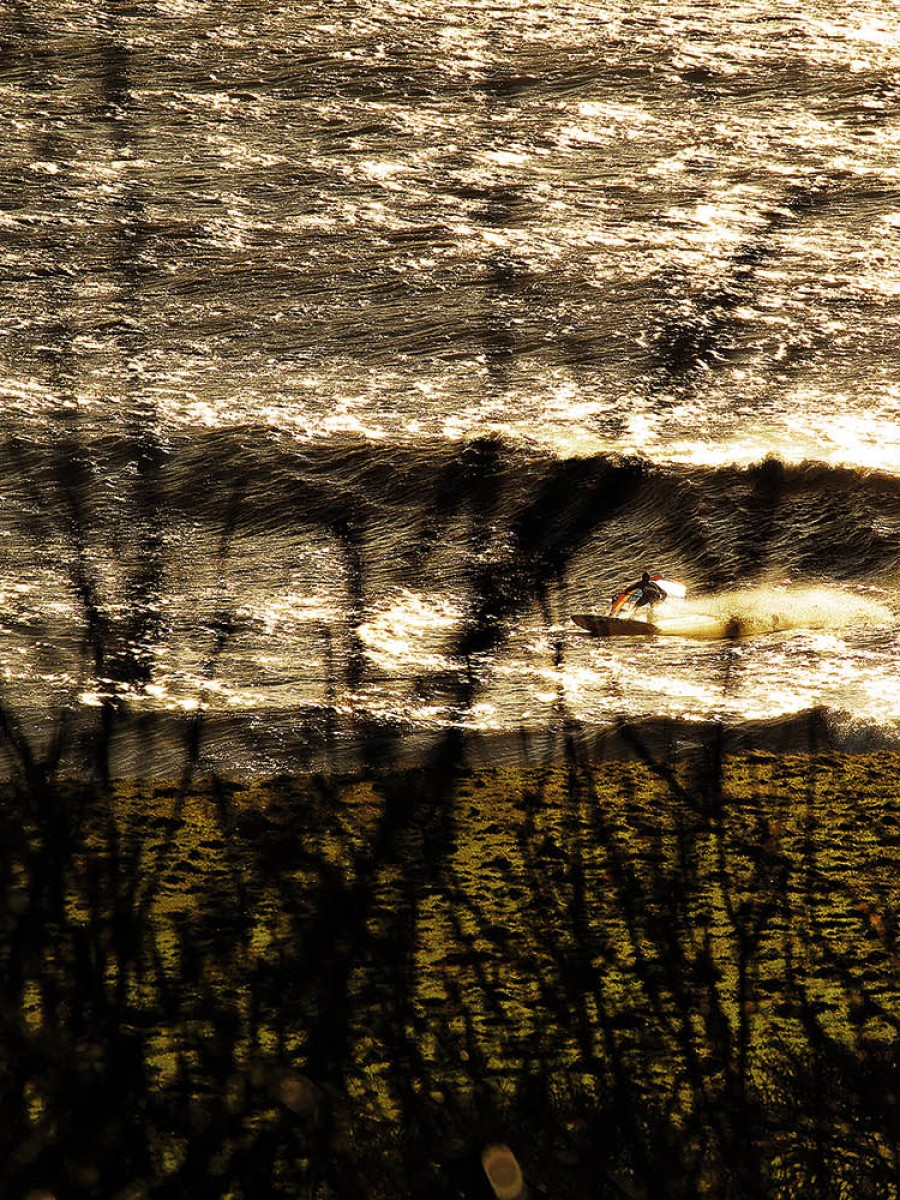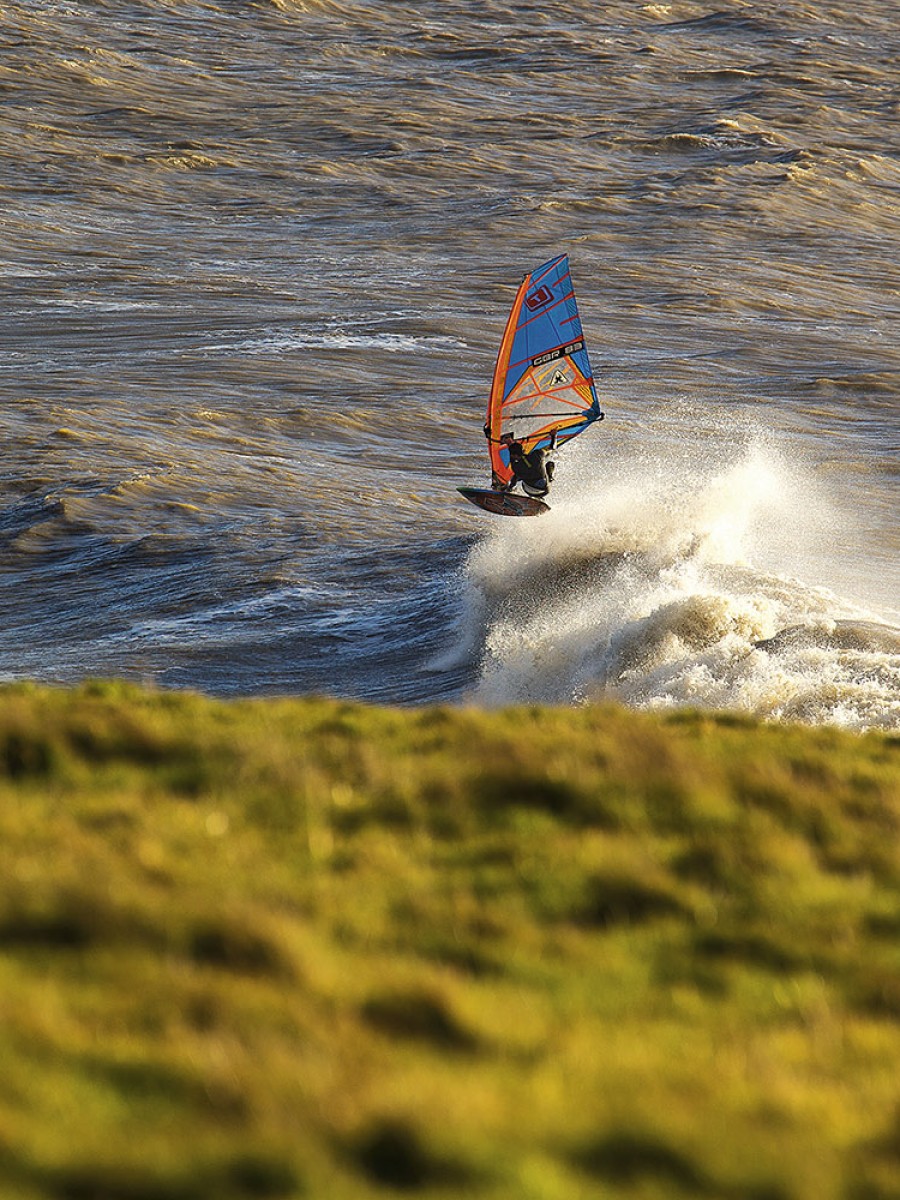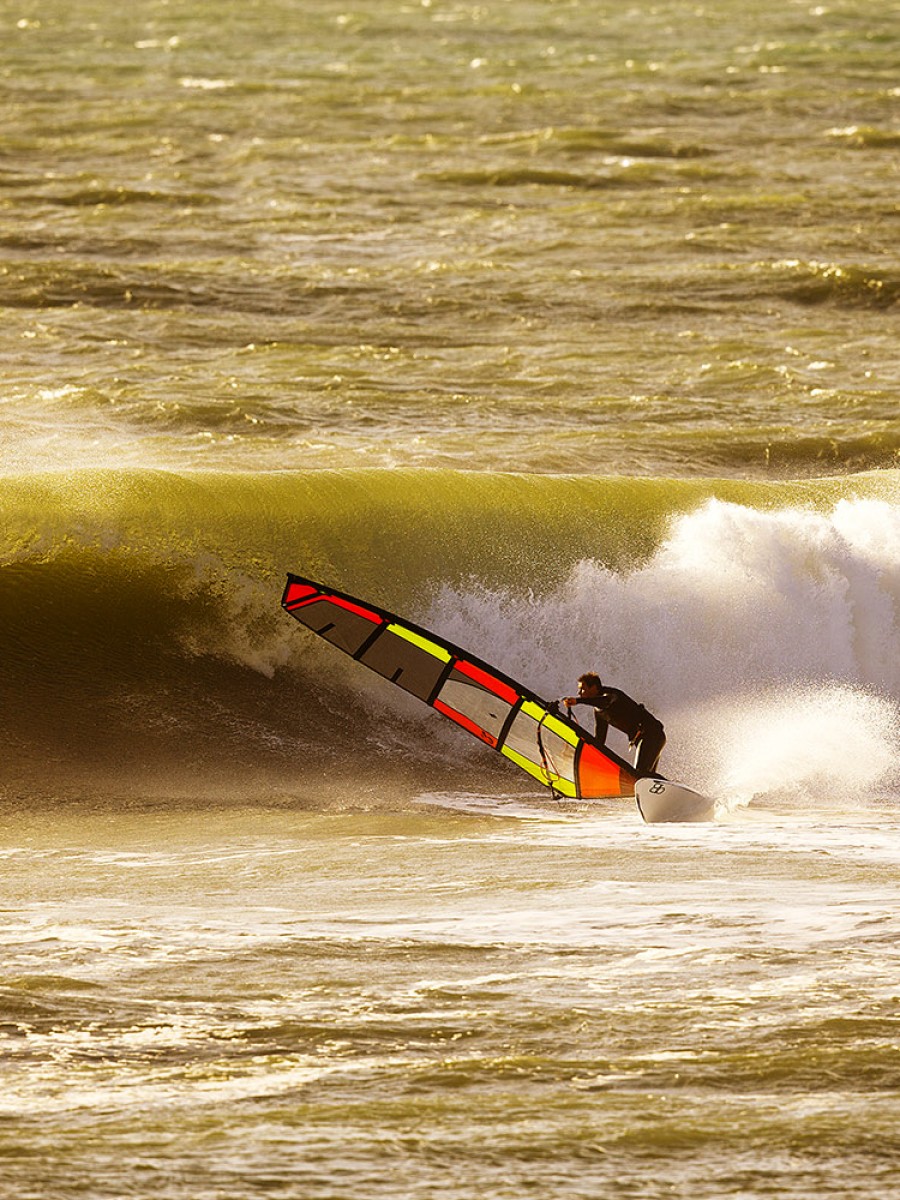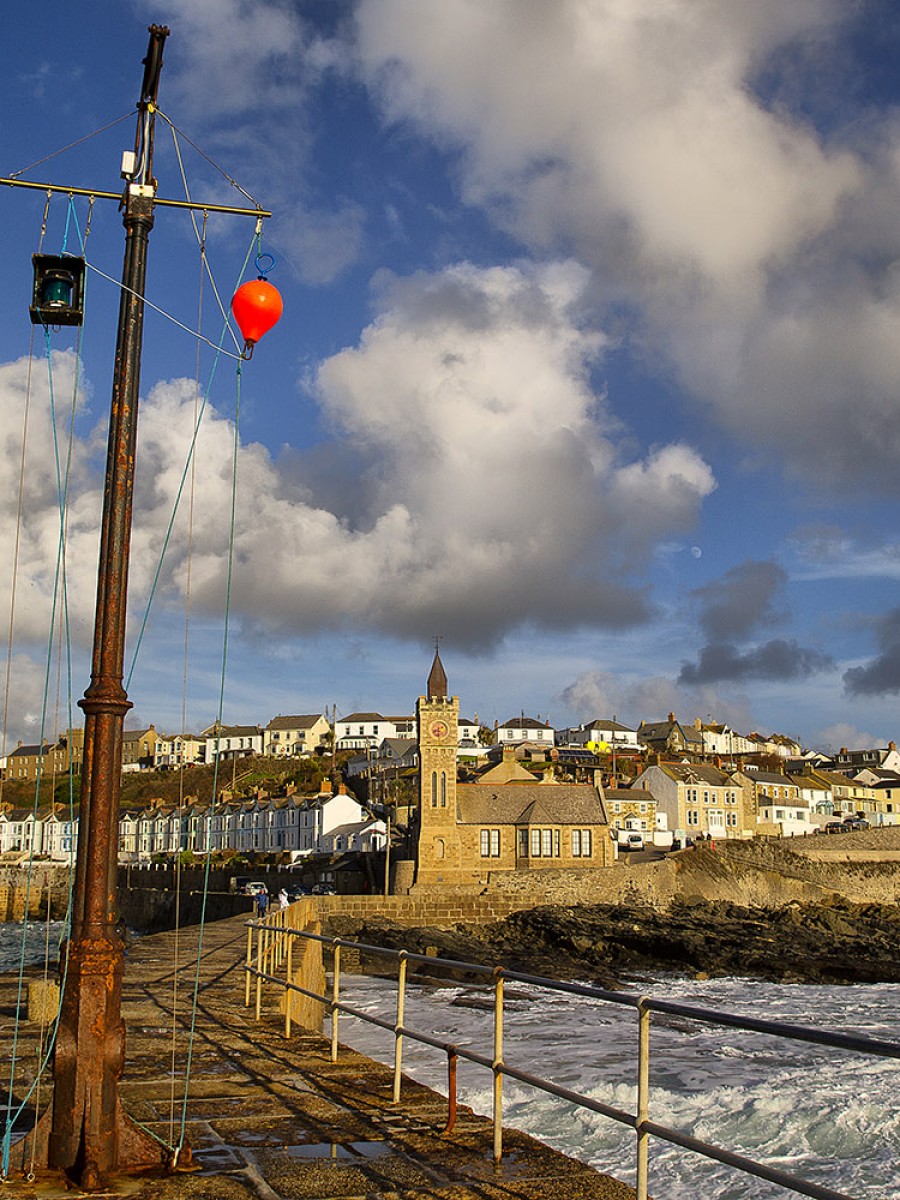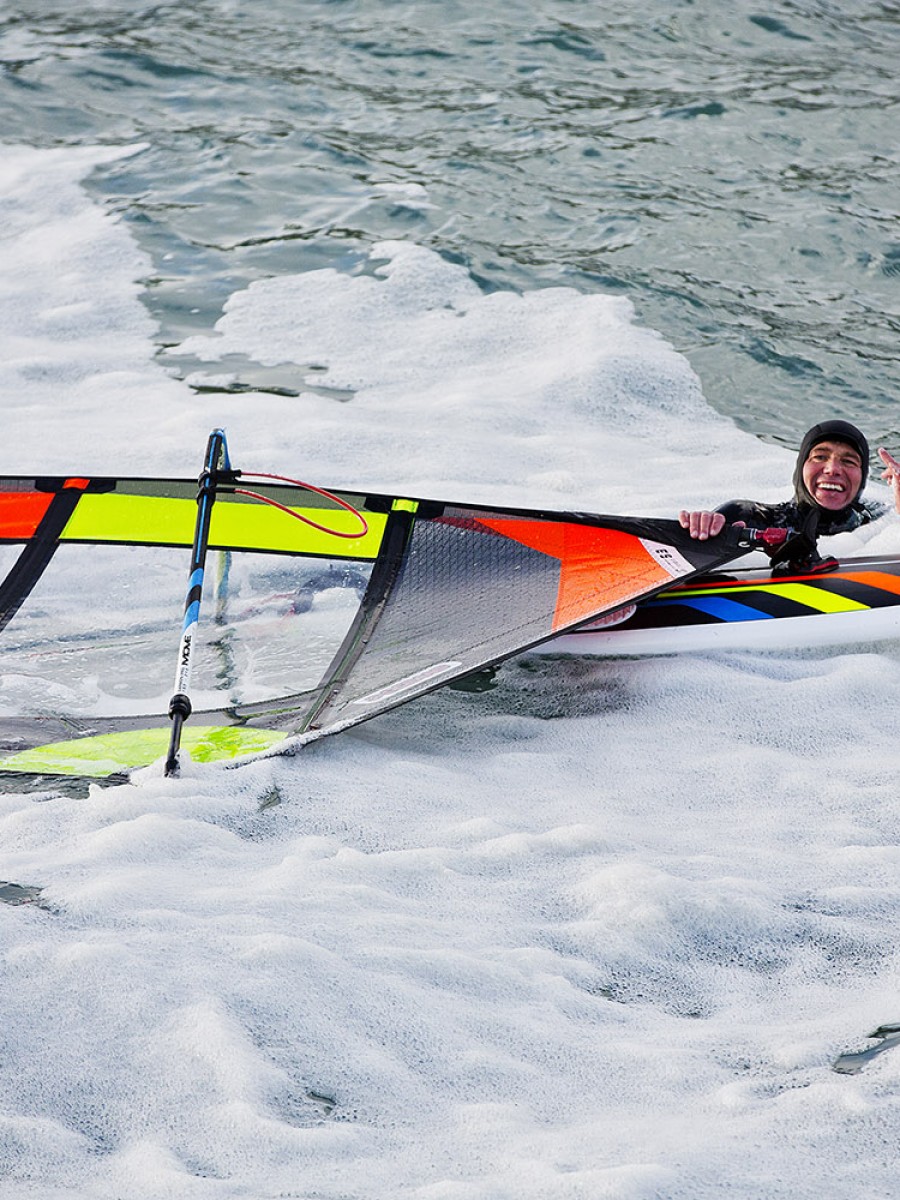STORM FORCE - BEAUTY AND THE BEAST

STORM FORCE – BEAUTY AND THE BEAST
Tucked away down a narrow country lane between Rock and Padstow, Daymer Bay is without doubt one of the most gorgeous stretches of coastline in Cornwall. It is a fantastic all round location, offering anything from flat water blasting, to jump and jump, right through to hard core waves. With Stepper Point to one side and Trebetherick point on the other guarding the Camel Estuary , you would assume that this sheltered area of outstanding natural beauty is a safe haven from the big winter storms, but catch it on the right day and Daymer can be a devil in disguise and serve up some extremely brutal conditions.
Catching Daymer firing, is all about knowing how this place works, with tides, wind and swell directions absolutely critical. The Motley Crew are not normally ones to shy away from the brunt of any big storm but once in a while, when every other beach is off the hook, the natural amphitheatre of wind and waves at Daymer becomes an serious option.
Words & Photos JOHN CARTER
(This feature originally appeared in the March 2015 issue of Windsurf Magazine. To read more features like this first, Print and Digital subscriptions are available. Prices include delivery globally for 10 x issues a year!)

Storm Chasing
MISSION ONE
Rewind way back to early January when the weather was at its wildest with the latest in a rapid series of sub 950 low pressures unleashing its fury on the UK. Myself, Timo Mullen, Ross Williams, Chris Murray and Andy King had all pretty much overdosed on Christmas and were gagging to get out there and challenge the elements. With wild winds and massive swell set to pound the Cornish coast, we decided it was time to hit Daymer Bay, hoping for a nice wrapping swell with groomed lines held up by the storm force winds. ‘Hoping’ was the key word here; when the weather is off the scale like this with unprecedented conditions, the illusion that you can just waltz around to the nearest sheltered headland and score wave sailing utopia is exactly that. After driving four hours down to the West Country our convoy of wagons finally rolled into the car park at Daymer with high expectations but on arrival high tide with a massive surge made it unsailable for the time being. A quick walk around the headland in the blustery 40 knot plus winds to check the waves rolling into Polzeath was enough to keep us hanging on. Huge sets were smashing into the headland, feathered by the cross off winds. Strangely enough, it was almost flat on the inside at Daymer, so we waited for the tide to race out and that it did. With such a huge surge racing into the Estuary all that water at some point had to go back out on the ebbing tide and sure enough within an hour or so as the water dropped out, the swells started to jack up right across the bay. Huge sets were breaking across the notorious Doom Bar while the inside beach break was forming up nicely. But the massive surge heading out combined with all the chop, swell and churned up water was making for a horrific sea state which was far from the image we had been hoping for.
Committed to Daymer the crew bravely rigged and headed out into the warzone in the extreme conditions. Survival it was, fair play to all the crew who battled the wild chop, gusty wind, driving rain and extremely dangerous outgoing tide. The ridiculous rip and huge close out sets marching through the mouth of the bay made it pretty much impossible to sail on the Doom Bar, with the sea state out of control and far too dangerous to risk any sort of crash or broken kit in the thick of the waves. After two hours of hard-core sailing in the icy winds the crew were ‘over it’ and rather than the usual state of euphoria after a decent session, everyone who had been on the water were dejected by the horrific conditions. Nobody was even up for a pint of Doom Bar (My favourite brew) so without further ado the mission was aborted and we headed home with the feeling that maybe we had been in the wrong place for this huge storm.
“ When every other beach is off the hook, the natural amphitheatre of wind and waves at Daymer becomes a serious option ’’ JC
MISSION TWO
After hitting Daymer at high tide, which was definitely the wrong call, I was determined to head back to score this place without such chaos on the water. The lesson had been learned, outgoing tide on an 8m swell with force eight plus southwest winds was a no go! With the wild winter continuing to deliver these absurd storms, it did not take long until the next opportunity came my way, February the 1stto be precise. Another sub 950 low, over 8m swell predicted and storm force winds but crucially this time it would be low tide coming in. The return to Daymer did not quite have the same level of takers as the first mission for some strange reason. Maybe the others had already learned their lesson. Despite being one of the most user friendly beaches in Cornwall in normal conditions, perhaps when its off the Richter scale this place gets too hot to handle. This time round Muzza and Adam Lewis were the only crew available with the desire to chase down another storm surge at Daymer.
So another freezing winters day beckoned. I had to take the train down the night before and stay in Adam Lewis’s family home in Taunton. We were right in the middle of that whole nasty spell of floods and storm damage and one of my main hopes was simply not to get stuck in all the travel chaos. En route stories of disruption were all the news on the radio but somehow we made it through the winding lanes to Daymer without any major hitches. On arrival, we turned up pretty much bang on low tide with a strong cross off shore wind blowing across the channel. It kind of looked like game on but Adam reckoned we should hang on a bit for the tide to push over the sweet spot where it would hit the Doom Bar.
Another gloomy day ensued with bracing winds, hail showers and the Atlantic raging with all its power. With the incoming tide the option to sail the Doom Bar was viable although out off Stepper Point huge waves were crashing onto the rock sending up massive explosions of white water. Solid logo to mast high sets were running down the headland with side off winds tempting both Adam and Chris to venture across the bay. As the tide raced in, this ‘sweet spot’ lasted about an hour before, the whole set up changed as the bay filled with water and the inside beach break started to turn on. Sailing these gnarly conditions in the midst of winter you should play it safe although Adam seemed to be ignoring the dangers of these perilous seas and racing out towards the steepest ramps in the thick of the impact zone and launching into some massive back loops. When Adam was learning to wave sail, Daymer Bay and Polzeath were his two favourite breaks and at least I had the peace of mind that he knows these waters and how hard to push it. Not to be outdone, Muzza was taking no prisoners on the Bar and hitting some chunky sections and launching into some huge floaty aerials.
Towards the end of the session the sky became engulfed by a huge thick blanket of grey cloud combined with 40 knots gusts and driving rain. By this time, even I was over it; the Doom Bar was calling, and not the one out in the middle of the Estuary! OK, Adam and Chris both survived the challenge of raging seas but that was nothing compared to my battle with National Rail to make it back to Portsmouth before the last boat. After being rerouted to some weird and wonderful stations dotted around the West Country I finally made it back home before midnight bedraggled and beaten by the UK railway system. Such was my horrific treatment by some of the station guards I even penned a letter of complaint and posted it off the very next morning, grrrr!
ANDY KING’S INSIDE INFO
Daymer has always been what I class as a fun spot. Only very occasionally full on classic as in down the line perfection but regularly delivering solid wave sailing conditions with great jumping and riding but be warned these conditions can change dramatically with the tide. Best conditions are in a NW wind with mid to high tide and moderate to big westerly swell. You then get cross shore wave sailing on both sides of the estuary. Smaller Starboard tack jumping on the car park side and bigger port tack riding across on the far side. West wind can also be good and although the car park side is far more onshore the far side is much cleaner for riding if a little gusty for jumping. With wind from the north and big swell it is the car park side that turns on but avoid high tide as there is a large wind shadow. The car park side can also be very good in a south westerly and moderate swell for cross on jumping with an incoming mid tide. Plus points – offers great variety of conditions and great place for beginners and intermediates to get out into the waves, offers great jumping for even the advanced wave sailor. Negatives – tide greatly effects conditions with spring tide to be avoided and best practise to catch tide against wind if possible. Car park charges, attendant will fleece an additional charge of 1.50 for each sailor / kiter on top of the standard parking charge….be warned!
“ Daymer Bay is without doubt one of the most gorgeous stretches of coastline in Cornwall ’’ JC
“ Daymer Bay is without doubt one of the most gorgeous stretches of coastline in Cornwall ’’ JC
ADAM LEWIS
When I saw the forecast I was really excited, I hadn’t had a chance to get a good session at Daymer for years. It’s a place that is kind of special to me, back in the Team Airborn days George’s family had an unreal cottage overlooking the bay and we used to sail there a lot. We even used to get abandoned there on windy weekends, sail all day and then walk to Padstow for fish and chips. Over the years we’ve had some awesome sessions. I just guess I have a lot of fond memories of the place and it’s not often it disappoints. I tend to look for a W/SW wind with a slightly larger swell. Actually it works a lot and its usually a bit windier than anywhere else. The only thing you need to be careful of is the tide, if its on the way out there is a lot of water moving out to sea and if there is a big swell it can be really, really choppy almost un-sailable.
The day we sailed it I wasn’t sure what to expect. I’d scored a session in Polzeath the day before but the wind was pretty sketchy and the waves were a bit funky, then as Muzza arrived the wind dropped and the waves went. All that was left was a pretty strong tide surge up the beach; actually I only got off the beach in my car just in time! Then the next day, it didn’t look so windy when we woke up. I was pretty worried but after picking up JC it seemed to pick up on the way. As we arrived we ran round the head land to check it out. My heart soared; it looked mental, mega waves out back and a sailable section at Doom Bar on the inside. We rigged as quick as possible and got out, I only had a 4.2 as my smallest so it made the decision pretty easy. I don’t think I had factored how windy it was until Muzza and I ran to the water. A squall came though and we could hardly walk with the gear.
At that minute I think we both realised what we were in for! With the low tide we sailed on the other side of the bay, it was mental out back, big lumps of ocean breaking and really gusty but if you timed it right you could get a solid wave, I saw Muzza get a pretty good smack! There were some sick ramps too and if you got a gust you could score some epic jumping, I was pretty worried though as you could easily land into a massive wall of whitewash, there was a lot of water moving around and you really didn’t want to be separated from your gear. When its like that its cool to have your buddy around just to keep an eye on each other, we were definitely a team out there that morning. As the tide came in we left Doom Bar and started to sail the beach break by the car park, it was pretty good fun, a bit of a relief after the first session. It was still super windy still but there was some more playful waves. All in all it was a pretty awesome day, a pretty mental first session and then heaps of fun in the afternoon. I was pretty sore in the evening!
PARKING
There is a decent sized car park with toilets and a shop.
GETTIING THERE
Take the A39 to Wadebridge or the A389 from Bodmin. Both these roads meet at a roundabout just NE of Wadebridge. From here you take the small road towards the town centre and after 100 metres you turn right onto the B3314 towards Rock. After a couple of miles there is a small crossroads where you turn left towards Pityme and Rock. At the T junction in Pityme turn left towards Rock and after 50 metres turn left towards Polzeath. About 1.5 miles later you will arrive in Trebetherick, head uphill and at the top take a sharp left down a narrow lane straight down into Daymer Bay. It is a bit of a fiddly place to find but this jewel of British windsurfing is well worth the effort.
WIND DIRECTIONS
North Perfect for blasting and waves on the Doom Bar.
NW Side shore starboard tack, it can be very dangerous on the outgoing tide.
W Cross on from the right.
SW Cross shore from the left, cross off on the far side of the bay.
S Not the best due to wind shadow from Brea Hill.
SE/ E/ NE Gusty winds, not recommended, better for surfing!
EDITORS NOTE
Daymer is in an estuary so watch out for outgoing tides which are best avoided if possible. I witnessed an experienced sailor get airlifted out of the Doom Bar after getting caught out on a outgoing tide and dropping wind. There is a decent sized car park with toilets and a shop.
DOOM BAR
The Doom Bar is the sandbar at the mouth of the estuary of the River Camel, composed mainly of marine sand that is continually being carried up from the seabed. According to tradition, the Doom Bar formed in the reign of Henry VIII, damaging the prosperity of the port of Padstow a mile up the estuary. A Cornish folklore legend however relates that a mermaid created the bar as a dying curse on the harbour after she was shot by a local man. Many ships have been wrecked on the Doom Bar and in 1848 Padstow Harbour Association cut down a small piece of Stepper Point to give ships extra “fair wind” into the harbour. Modern dredging techniques have widened the channel to reduce the hazard to Navigation but accidents have still occurred as recently as 1997. Nowadays its name is most famous as the flagship ale from Sharp’s Brewery just outside Rock. From surf dudes and city slickers to royalty and semi alcoholic windsurfing photographers, this mild 4% bitter has become the bestselling cask ale in the UK.
OTHER THINGS TO DO
The hidden gems on the Cornish Coast and a wonderful place to take the family in the summer. Maybe not quite so nice in a force 9 SW gale in the middle of January! The walk round to Polzeath is stunning and the beach at Daymer has beautiful white sand that stretches for miles. In the summer the traffic can be pretty hectic in and out of the narrow lane and without many passing points can be a bit of a nightmare. Polzeath nearby is a popular surf beach with one of the biggest surf shops in the UK and a well known hangout for holidaying celebrities – David Cameron normally hits the waves there every summer !

















The post STORM FORCE – BEAUTY AND THE BEAST appeared first on Windsurf Magazine.


















